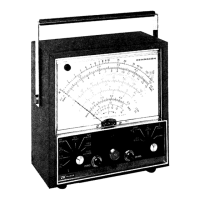This does not apply to the DC
scales, since in measuring
DC, no rectifiers
are
used.
The
colored Range
Switch
positions
and their
corresponding scales on the
meter
face are colored
just
to remind
you
that they indicate
peak-to-peak
AC
voltage
measurements,
RMS is an abbreviation
oI
"Root
Mean Square" which
is a
term
relating to a
sinewave of voltage
and
its
e{Iective or heating value, relating it
to an equivalent
DC
(direct
current) voltage. P-P is an
abbreviation of
"Peak-to-peak",
or the
total of
the
positive-going
and negative-going
voltages relative to a zero
voltage
axrc.
When we are
measuring a
sinewave of voltage, there is a fixed mathematical
relationship
between
RMS. Peak. and Peak-to-Peak:
Peak
is
1.41
times RMS.
Peak-to-Peak
is 2
times
peak.
Peak-to-Peak is 2.83
times
RMS.
RMS
is
.707 times
peak.
RMS is .353
times
peak-to-peali.
This relationship
is valid, only
when we are dealing
with a sine-wave voltage.
Since
there are almost an infinite number of rvaveforms
other than
sinewave it is
impossible within
the scope of this manual
to
make
any statement
of
relationship
between
RMS and
peak-to-peak
when dealing with
other than sinewaves; each
such complex waveform would
have to be analyzed aird a
proper
relationship
established.
USING THE DECIBEL
(Db)
SCALE
'l.he
human
ear responds in a logarithmic manner to variations in
sound
intensity
and not linearly-that is when the amount of sound is doubled,
the ear
responds to
it
so that we sense only a slight increase in loudness rather
than
a
doubled
increase.
A unit
of
loudness measure based on logarithms called
the
"bel"
was
adopted. The bel corresponds very nearly to
the
human ear response
vrrria-
tions. Normally,
loudness signal levels are
given
in tenths
of a bel, or decibels,
because
this unit
represents
the smallest variation in sound intensity
the ear can
detect. Manufacturers
use a variety of signal levels as a standard for zero
db. The
Db scale
uses
.001
watt
(1
milliwatt) into a
600
ohm
line
as zero db. This corre-
sponds to O.775
volt
AC on
the
0-5 volt scale.
The
decibel represents
a voltage ratio, and it may be
used
without
specifying
the reference level.
For
example, a response curve may
be
plotted
for an amplifier
by injecting a signal of variable frequency and constant amplitude, with
the VTVM
connected to the output.
Adjust
the signal
input
at some reference
frequency,
such
as 400
cycles, for a convenient indication on the VTVM.
(Zero
db
for exam-
ple.)
As
the input frequency is varied, the output variation may
be obset
r',1
in
db above and below the reference freouencv level.

